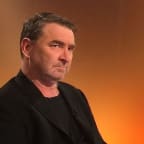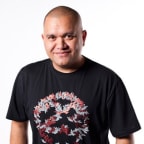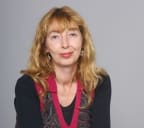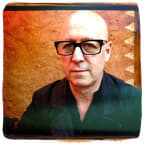Pauly Fuemana’s How Bizarre connected to early Auckland punk music
Two moments from Auckland musical history – the establishment of punk in the 1970s, and the worldwide success of Pauly Fuemana’s How Bizarre – are linked in surprisingly intricate ways.
What’s most obviously in common in the person of Simon Grigg, who managed the city’s first punk rock group, the Suburban Reptiles, in 1977. Later in his career in contemporary music career he would sign Pauly Fuemana to his Huh! record label and release the global hit which had such an impact on its creator’s life, and contributed to his untimely death.
But there’s a deeper sense of connection too between these musical phenomena, so different in style and making their presence felt in contemporary culture decades apart. It’s the sense of freedom afforded to those who were not bound by rules, because they were making them up as they went along.
By the mid-seventies, Simon Grigg had long wanted to be in the music industry, but his entry into it got help from close at hand. “Mum was a little bit frustrated,” Grigg recalls, “at the fact I was sitting round the house moping so she rang up Phil Warren – the most obvious person to ring up, I think – he was on television at the time. He was Mr Entertainment, he ran a whole chain of nightclubs and people from Ray Columbus through to the Chicks. She said ‘my son wants to be in the music industry.’ Phil, always a very open sort of guy, said ‘send him in.’”
So Grigg went to his office in Cook St, where Warren sat behind a massive desk surrounded by photos of him with musical celebrities such as Shirley Bassey. Asked by the entrepreneur what he wanted to do, Grigg replied “I want to make music.” And he said, “Well, go and make it. Just do it. Come up with an idea, don’t let anybody tell you that it’s not going to work.”
So, excited by this imprimatur, Grigg sat around for a while with university friends and talked about forming a jazz band. Then they recalled a small piece in the UK music magazine NME about this little-known band the Sex Pistols. And so the Suburban Reptiles were formed that day.
Although it seems hard to imagine it today, Parnell was punk central for a while. “All the cool flats were in Parnell,” says Grigg, “and there was the Windsor Castle bar which was run by the Lane brothers. And they seemed to have a far more open policy towards rock and roll than any other venue in the city. The Gluepot was very staid at that stage, and a lot of the punk bands just couldn’t get in there. All of a sudden this venue turned up. It had been a rock and roll venue for a while, and my brother in law Larry and my sister Fiona were booking the place. And they started to put Saturday afternoons on at the Windsor Castle. It wasn’t Parnell as we know it now! “
That feeling of making things up as you went along also characterized Grigg’s management of the musician who would attract great international acclaim, Pauly Fuemana. Grigg thinks the singer-songwriter’s biggest problem was his paranoia, which he attributes to his upbringing, his youth, “and the whole societal thing he came out of. “
The music industry is far stronger now than it was back then, he says, as “we were all learning. We had no idea. We were the first people to take a record overseas, and have a hit record in America. And we were told you couldn’t do it. So every single step we took was into the abyss, basically.”
His relationship with Fuemana got very fractured along the way, because of the fact that we were all trying to work out “what the hell was going on.” He also considers that the change in the muiscian’s lifestyle had been extreme: ”You took Pauly from a council flat in Greys Avenue and a year later he’s on Letterman. And he’s got millions of dollars flying at him. Drew Barrymore’s knocking on his hotel door and all that sort of stuff. It’s very very difficult. I look at Lorde and ask what’s it going to do to her. I think she’s probably better equipped than Pauly ever was.”
“She’s way better equipped,” adds Russell Brown in the panel discussion Smart Talk at the Auckland Museum, which explores a number of themes in the history of contemporary music to be found in the city.
About the participants

Photo: Supplied
Russell Brown - Moderator
Russell has been involved with music in Auckland since he moved north from Christchurch to become deputy editor of Rip It Up in 1983. Since then he has written for Sounds, Select, Music Week and The Catalogue in Britain and served as Rock columnist in The Listener. He has been both a DJ on 95bFM and chairman of the station’s board of directors. He staged New Zealand’s first acid house party, Housequake!, in 1989 and still occasionally DJs at Auckland venues. He writes a popular music post every Friday in his personal blog, Hard News, at publicaddress.net.

Photo: Supplied
Phil Bell (DJ Sir Vere)
Phil has been a DJ since he stepped up to the turntables at the age of 14 when his dad needed a toilet break – and hip hop has been his musical life since he saw ‘Beat Street’ at The Civic at the age of 17. He ran Auckland’s first 12-hour dance party, Planet Rock, in 1988, and founded bFM’s long-running Tru school Hip Hop Show, the huge Major Flavors hip hop compilation franchise and the Beat Merchants store, the centre of Auckland’s hip hop scene. He’s been the editor of Rip It Up magazine and programme director at Mai FM and has worked with everyone from Che Fu to Savage.

Rachel Lang Photo: Supplied
Rachel Lang
As co-creator (with James Griffin) of Outrageous Fortune and its “prequel” Westside, Rachel has told innately Auckland stories not only with words and images, but in song. Hello Sailor’s ‘Gutter Black’ led every episode of Outrageous Fortune and in this year’s Westside contemporary music has brought to life both story and history. We visited Hello Sailor’s infamous Ponsonby pad "Mandrax Mansion”, saw a young Dave McArtney (played by Dave’s son) working out the chords to ‘Gutter Black’, visited Auckland’s first punk rock club Zwines, and experienced a moving resolution to the strains of Split Enz’s classic ’Stuff and Nonsense’. The creators have underlined the importance of the songs by publishing the soundtrack for each episode. But the importance of music to Rachel’s stories goes back much further – through Shortland Street and 1996’s City Life, which was threaded through with local pop music and scenes from Auckland’s musical nightlife. She’s a fan.

Dave Dobbyn Photo: Supplied
Dave Dobbyn
Dave Dobbyn was born in the working-class Auckland suburb of Glen Innes and got his musical education from the sounds around him: the Irish songs in the home, the singing in the church over the road and the tunes on the radio. He joined a band and he grew up to write the songs of the city. For more than 20 years, he has lived in Grey Lynn, the national capital of songwriting.
Simon Grigg
Simon has been at the centre of Auckland’s musical history since, inspired by a childhood meeting with legendary Auckland promoter and manager Phil Warren, he assembled and managed the city’s first punk rock group, the Suburban Reptiles, in 1977.
He went on to form the city’s first indie record label, Propeller, and ran its most famous nightclub, The Box.

Simon Grigg Photo: Photo by Stuart Page
And then he signed Pauly Fuemana to his Huh! record label and released the global hit ‘How Bizarre’ – a story told in his new book How Bizarre: Pauly Fuemana and the song that stormed the world. The book was published by Awa Press in August 2015. From the author’s note:
"How Bizarre is also a little more than that, it’s the story of a coming together of the cultures in Auckland – it's the time when the first generation of young Polynesians born in New Zealand from that great immigration of the1960s and 1970s came to town and changed our city forever. How Bizarre, the song, is a child of that uniquely Auckland phenomenon.”
Simon is now the creative director of the New Zealand music legacy website Audioculture. Read his full bio here.
This programme was recorded in partnership with the Auckland Museum

